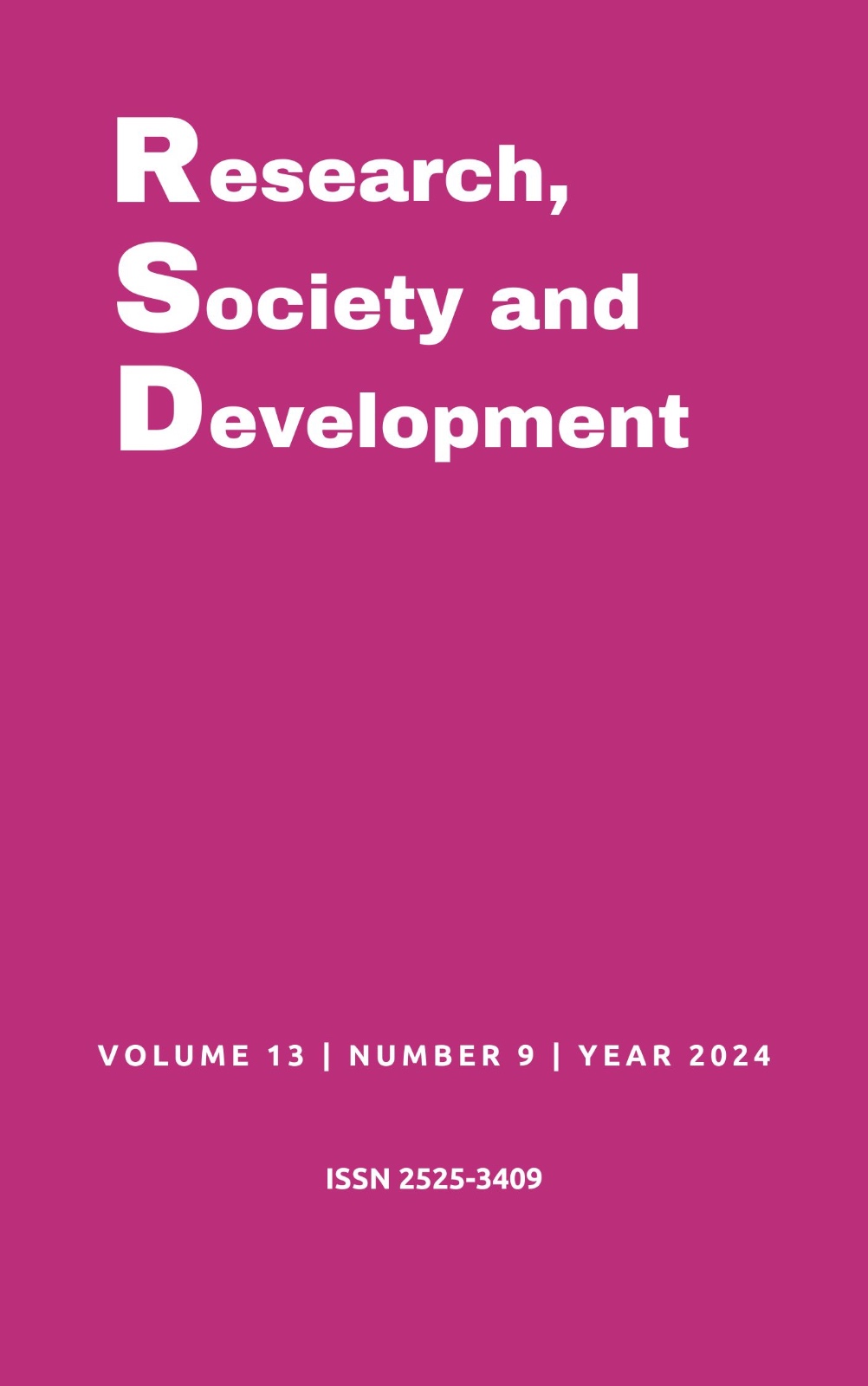Manejo do choque anafilático no pronto socorro: Uma revisão de literatura
DOI:
https://doi.org/10.33448/rsd-v13i9.46826Palavras-chave:
Choque anafilático, Manejo de emergência, Adrenalina, Vias aéreas, Fluidos intravenosos, Protocolos de emergência, Educação do paciente.Resumo
O choque anafilático é uma reação alérgica grave e potencialmente fatal que requer intervenção imediata. Esta revisão de literatura tem como objetivo analisar as estratégias de manejo do choque anafilático no pronto socorro, destacando a importância da administração precoce de adrenalina, manutenção das vias aéreas e administração de fluidos intravenosos. A pesquisa foi realizada nas bases de dados Google Acadêmico, LILACS e SCIELO, abrangendo publicações de 2000 a 2024 nos idiomas português, inglês e espanhol. Os resultados indicam que a falta de conhecimento e treinamento adequado entre os profissionais de saúde pode atrasar o tratamento, exacerbando a gravidade da condição. Além disso, a revisão aponta para a necessidade de protocolos padronizados e educação contínua dos profissionais de saúde para melhorar os desfechos dos pacientes. A educação do paciente e a prevenção de futuras reações são componentes críticos do manejo do choque anafilático, destacando a importância de estratégias preventivas e de acompanhamento a longo prazo.
Referências
Anderson, J. L., & Morrow, D. A. (2017). Acute coronary syndrome. New England Journal of Medicine, 376(14), 1283-1295.
Bohlke, K., Davis, R. L., DeStefano, F., Marcy, S. M., Braun, M. M., Thompson, R. S., ... & Mullooly, J. P. (2003). Epidemiology of anaphylaxis among children and adolescents enrolled in a health maintenance organization. Journal of Allergy and Clinical Immunology, 113(3), 536-542.
Brown, S. G. (2004). Clinical features and severity grading of anaphylaxis. Journal of Allergy and Clinical Immunology, 114(2), 371-376.
Cardona, V., Ansotegui, I. J., Ebisawa, M., El-Gamal, Y., Fernandez Rivas, M., Fineman, S., ... & Sheikh, A. (2020). World allergy organization anaphylaxis guidance 2020. World Allergy Organization Journal, 13(10), 100472.
Ibanez, B., James, S., Agewall, S., Antunes, M. J., Bucciarelli-Ducci, C., Bueno, H., ... & Widimsky, P. (2018). 2017 ESC Guidelines for the management of acute myocardial infarction in patients presenting with ST-segment elevation. European Heart Journal, 39(2), 119-177.
Järvinen, K. M., & Sicherer, S. H. (2012). Epidemiology of anaphylaxis. Immunology and Allergy Clinics, 32(1), 1-17.
Kemp, S. F., Lockey, R. F., Simons, F. E., & World Allergy Organization ad hoc Committee on Epinephrine in Anaphylaxis. (2008). Epinephrine: the drug of choice for anaphylaxis. A statement of the World Allergy Organization. Allergy, 63(8), 1061-1070.
Lieberman, P., Nicklas, R. A., Randolph, C., Oppenheimer, J., Bernstein, D., Bernstein, J., ... & Wallace, D. (2015). Anaphylaxis—a practice parameter update 2015. Annals of Allergy, Asthma & Immunology, 115(5), 341-384.
Muraro, A., Roberts, G., Worm, M., Bilò, M. B., Brockow, K., Fernández Rivas, M., ... & Sheikh, A. (2014). Anaphylaxis: guidelines from the European Academy of Allergy and Clinical Immunology. Allergy, 69(8), 1026-1045.
Pumphrey, R. S. (2000). Lessons for management of anaphylaxis from a study of fatal reactions. Clinical and Experimental Allergy, 30(8), 1144-1150.
Ring, J., Beyer, K., Biedermann, T., Bircher, A., Duda, D., Fischer, J., ... & Worm, M. (2014). Guideline for acute therapy and management of anaphylaxis. Allergo Journal International, 23(3), 96-112.
Sheikh, A., Shehata, Y. A., Brown, S. G., & Simons, F. E. (2009). Adrenaline for the treatment of anaphylaxis: Cochrane systematic review. Allergy, 64(2), 204-212.
Simons, F. E. (2010). Anaphylaxis. Journal of Allergy and Clinical Immunology, 125(2), S161-S181.
Simons, F. E., Ardusso, L. R., Bilò, M. B., El-Gamal, Y. M., Ledford, D. K., Ring, J., ... & World Allergy Organization. (2011). World Allergy Organization guidelines for the assessment and management of anaphylaxis. World Allergy Organization Journal, 4(2), 13-37.
Simons, F. E., Ardusso, L. R., Bilò, M. B., El-Gamal, Y. M., Ledford, D. K., Ring, J., ... & World Allergy Organization. (2015). Update: World Allergy Organization anaphylaxis guidelines: 2015. World Allergy Organization Journal, 8(1), 32.
Simons, K. J., & Simons, F. E. (2012). Epinephrine and its use in anaphylaxis: current issues. Current Opinion in Allergy and Clinical Immunology, 12(4), 354-361.
Sicherer, S. H., & Sampson, H. A. (2014). Food allergy: Epidemiology, pathogenesis, diagnosis, and treatment. Journal of Allergy and Clinical Immunology, 133(2), 291-307.
Turner, P. J., Jerschow, E., Umasunthar, T., Lin, R., Campbell, D. E., & Boyle, R. J. (2017). Fatal anaphylaxis: Mortality rate and risk factors. Journal of Allergy and Clinical Immunology, 139(2), 556-567.
Wood, R. A., Camargo Jr, C. A., Lieberman, P., Sampson, H. A., Schwartz, L. B., Zitt, M., & Collins, M. (2014). Anaphylaxis in America: the prevalence and characteristics of anaphylaxis in the United States. Journal of Allergy and Clinical Immunology, 133(2), 461-467.
Worm, M., Moneret-Vautrin, A., Scherer, K., Lang, R., Fernandez-Rivas, M., Cardona, V., ... & Beyer, K. (2014). First European data from the network of severe allergic reactions (NORA). Allergy, 69(10), 1397-1404
Downloads
Publicado
Edição
Seção
Licença
Copyright (c) 2024 Felipe de Abreu Medeiros; Lucas Hosken Vieira Oliveira; Renato Pereira Brandt; Rafael Ney Silva; Matheus Eduardo Siqueira da Silva de Araújo; Vitória de Lima Fujinami Tano; Pedro Gabriel Kaefer de Oliveira; Milena Goulart da Fonseca; Wesley Souza Silva; Camila de Oliveira Passos Rodrigues Dayube; Henrique Souza Costa; Carlos Eduardo Pinheiro Leal Brigido; Charles Bonatti do Vale Silva; Mayara Duarte Silva; Gustavo Giacomazzi

Este trabalho está licenciado sob uma licença Creative Commons Attribution 4.0 International License.
Autores que publicam nesta revista concordam com os seguintes termos:
1) Autores mantém os direitos autorais e concedem à revista o direito de primeira publicação, com o trabalho simultaneamente licenciado sob a Licença Creative Commons Attribution que permite o compartilhamento do trabalho com reconhecimento da autoria e publicação inicial nesta revista.
2) Autores têm autorização para assumir contratos adicionais separadamente, para distribuição não-exclusiva da versão do trabalho publicada nesta revista (ex.: publicar em repositório institucional ou como capítulo de livro), com reconhecimento de autoria e publicação inicial nesta revista.
3) Autores têm permissão e são estimulados a publicar e distribuir seu trabalho online (ex.: em repositórios institucionais ou na sua página pessoal) a qualquer ponto antes ou durante o processo editorial, já que isso pode gerar alterações produtivas, bem como aumentar o impacto e a citação do trabalho publicado.


